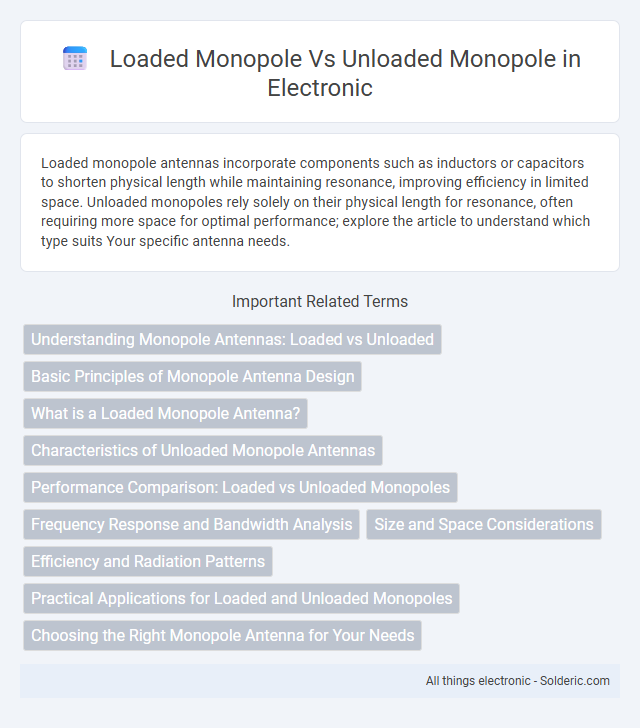Loaded monopole antennas incorporate components such as inductors or capacitors to shorten physical length while maintaining resonance, improving efficiency in limited space. Unloaded monopoles rely solely on their physical length for resonance, often requiring more space for optimal performance; explore the article to understand which type suits Your specific antenna needs.
Comparison Table
| Feature | Loaded Monopole | Unloaded Monopole |
|---|---|---|
| Length | Shorter due to loading coil | Full quarter-wavelength |
| Size | Compact, space-saving | Physically longer |
| Bandwidth | Narrower bandwidth | Wider bandwidth |
| Efficiency | Lower radiation efficiency | Higher radiation efficiency |
| Tuning | Requires precise tuning of loading element | No additional tuning required |
| Frequency | Effective for lower frequencies in smaller size | Designed for resonant frequency at quarter wavelength |
| Complexity | More complex construction | Simpler design |
| Applications | Mobile devices, limited space installations | Fixed stations, base stations |
Understanding Monopole Antennas: Loaded vs Unloaded
Loaded monopole antennas incorporate inductors or capacitors to electrically shorten the antenna while maintaining resonance, making them ideal for limited space applications. Unloaded monopole antennas operate at their natural length, offering better efficiency and bandwidth but requiring more physical space. Understanding these differences helps you choose the optimal antenna design for your specific signal performance and spatial constraints.
Basic Principles of Monopole Antenna Design
Loaded monopole antennas incorporate inductive or capacitive elements to electrically lengthen the antenna, improving impedance matching and bandwidth within a compact size. Unloaded monopoles rely solely on physical dimensions, typically requiring longer lengths to achieve resonance at lower frequencies. Your choice between loaded and unloaded monopoles affects design trade-offs like antenna efficiency, size constraints, and frequency response.
What is a Loaded Monopole Antenna?
A loaded monopole antenna incorporates inductive or capacitive components to electrically lengthen the antenna without increasing its physical height, enhancing performance at lower frequencies. This contrasts with an unloaded monopole, which relies solely on its physical length to determine resonant frequency and bandwidth. Loaded monopoles achieve improved impedance matching and compactness, making them suitable for limited-space applications where a full-sized monopole is impractical.
Characteristics of Unloaded Monopole Antennas
Unloaded monopole antennas feature a simple, straight conductive element without additional components, resulting in a resonant frequency determined primarily by the length of the radiator, typically a quarter-wavelength of the desired frequency. These antennas exhibit broad bandwidth and relatively high radiation efficiency due to the absence of loading elements, but their physical size can be large for lower frequencies, making them less compact for certain applications. You benefit from their straightforward design and ease of fabrication when prioritizing efficiency and bandwidth over antenna miniaturization.
Performance Comparison: Loaded vs Unloaded Monopoles
Loaded monopoles use inductive or capacitive elements to electrically lengthen the antenna, improving performance in restricted physical spaces where a full-sized monopole isn't feasible. Unloaded monopoles typically provide better efficiency and bandwidth due to their physically resonant length but require more space. You can optimize antenna design by choosing loaded monopoles for compact installations while prioritizing unloaded monopoles when maximum radiation efficiency and bandwidth are critical.
Frequency Response and Bandwidth Analysis
Loaded monopole antennas use inductive or capacitive loading components to effectively reduce the physical length while maintaining resonance at lower frequencies, resulting in a narrower bandwidth compared to unloaded monopoles of the same electrical length. Unloaded monopoles provide a wider frequency response and broader bandwidth due to their full physical length, which supports efficient radiation over a greater frequency range. Frequency response analysis shows that loading shifts the resonant frequency without significantly increasing the antenna size, but it compromises bandwidth performance, making unloaded monopoles preferable for wideband applications.
Size and Space Considerations
Loaded monopole antennas occupy significantly less physical space than unloaded monopoles by incorporating inductive or capacitive loading components that electrically lengthen the antenna without increasing its height. This compact design makes loaded monopoles ideal for applications with strict size constraints, such as urban environments or mobile platforms. Your choice between loaded and unloaded monopoles depends on balancing available installation space with desired antenna performance and frequency coverage.
Efficiency and Radiation Patterns
Loaded monopoles exhibit reduced efficiency compared to unloaded monopoles due to the insertion of loading elements such as inductors or capacitors, which introduce resistive losses and lower the antenna's radiation resistance. The radiation pattern of a loaded monopole remains omni-directional in the horizontal plane but often exhibits a lower overall gain and narrower main lobe due to the shortened electrical length. Unloaded monopoles typically provide higher efficiency and a more robust radiation pattern with stronger low-angle radiation, making them preferable for applications requiring maximum signal strength and coverage.
Practical Applications for Loaded and Unloaded Monopoles
Loaded monopoles enhance antenna performance in compact spaces by incorporating inductive or capacitive elements, making them ideal for portable communication devices and urban cellular networks. Unloaded monopoles, with their simpler design and longer length, serve efficiently in applications requiring broader bandwidths and higher radiation efficiency, such as marine and aviation communication systems. Your choice depends on space constraints and performance needs, with loaded monopoles offering versatility in size-sensitive environments.
Choosing the Right Monopole Antenna for Your Needs
Loaded monopole antennas use inductors or coils to electrically lengthen the antenna, allowing for a shorter physical size without sacrificing performance, ideal for space-constrained installations. Unloaded monopoles rely on their physical length to achieve resonance, typically providing better efficiency and bandwidth but requiring more space. When choosing the right monopole antenna for your needs, consider the trade-off between size constraints and performance requirements to ensure optimal communication quality.
loaded monopole vs unloaded monopole Infographic

 solderic.com
solderic.com